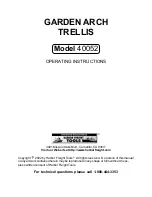
11
Use
Rope Grab Subsystem
US
3
Use
3.1
Planning the Use of Systems
3.1.1 Rescue and Evacuation
The user must have a rescue plan and the means at hand to implement it. The plan must take into account
the equipment and special training necessary to effect prompt rescue under all foreseeable conditions. If
the rescue will be from a confined space, the provisions of OSHA regulation 1910.146 and ANSI Z117.1
must be taken into account.
3.1.2 Pendulum (Swing) Falls
Swing falls can occur when the system is not anchored directly above the user. The force of striking an
object in a pendular motion can cause serious injury or death. Always minimize swing falls by working as
directly below the anchorage point as possible.
3.2
Rope Grab Inspection Before Each Use
Inspect the Rope Grab subsystem to verify that it is in serviceable condition. Examine every inch of the Rope
Grab working rope line for severe wear, frays or broken strands, cuts, or other damage.
Inspect the shock absorbing lanyard to verify it is in serviceable condition. Examine every inch of the
webbing for severe wear, cuts, burns, frayed edges, abrasion, discoloration, or other damage.
Examine stitching for any pulled, loose or torn stitches. Inspect the hardware to verify they are functional
and free from cracks, breaks, missing or loose parts. Examine the Rope Grab device for missing, broken,
altered or damaged parts. Do not use the Rope Grab if the inspection of any component reveals an unsafe
condition. Additionally, the Rope Grab subsystem must be inspected by a competent person other than the
user at intervals of no more than six months.
3.3
Making Connections
3.3.1 Anchorage Connection
Attach the carabiner on the lifeline to the overhead anchorage connector. The other end of the lifeline must
hang to the ground or some distance below the next working level. Heavy padding must be used to protect
the lifeline from sharp edges.
3.3.2 Usage
Manual Fall Arrest Mode
If the manual rope grab is purchased separately, to install the rope grab begin by untying the knot at the end
of the vertical lifeline (if present). Feed the lifeline through the rope grab and then tie a knot at the end of
the vertical lifeline. Ensure that the arrow on the rope grab (see figure 1) always points toward the ancho-
rage. These particular devices will NOT follow the user freely up or down the lifeline without user interven-
tion. Attach snaphook on lanyard to back D-ring of a full body harness. To move the rope grab along the
vertical lifeline, depress the lever towards the anchorage, which releases the locking levers (figure 1). Never
move the rope grab without stable footing. Never manipulate or hold the fall arrester body or lever, instead
move the fall arrester up/down by the lanyard component.
WARNING
If the Rope Grab or lifeline has been subjected to fall arrest forces, it must be immediately removed
from use and destroyed.
Summary of Contents for 415865
Page 9: ...9 Description Rope Grab Subsystem US...
Page 20: ...For local MSA contacts please visit us at MSAsafety com Because every life has a purpose...
Page 30: ...10 Description Sous syst me de coulisseau de s curit CA...
Page 40: ...For local MSA contacts please visit us at MSAsafety com Because every life has a purpose...
Page 50: ...10 Descripci n Subsistema de sujetador de cuerda MX...
Page 60: ...For local MSA contacts please visit us at MSAsafety com Because every life has a purpose...












































